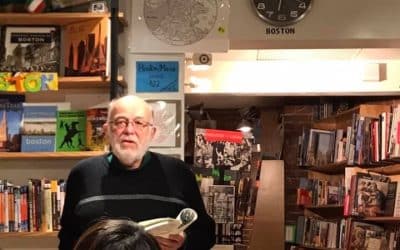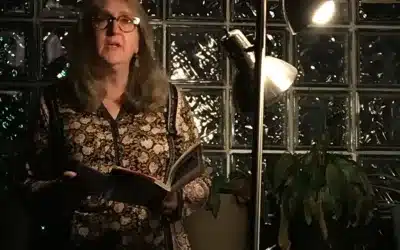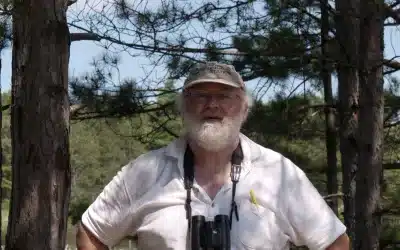Sharon Mesmer is a Polish-American poet, fiction writer, essayist and professor of creative writing. Her poetry collections are Greetings From My Girlie Leisure Place (Bloof Books, 2015), Annoying Diabetic Bitch (Combo Books, 2008), The Virgin Formica (Hanging Loose Press, 2008), Vertigo Seeks Affinities (chapbook, Belladonna Books, 2007), Half Angel, Half Lunch (Hard Press, 1998) and Crossing Second Avenue (chapbook, ABJ Press, Tokyo, 1997, published to coincide with a month-long reading tour of Japan sponsored by American Book Jam magazine). Her fiction collections are Ma Vie à Yonago (Hachette Littératures, Paris, in French translation by Daniel Bismuth, 2005), In Ordinary Time (Hanging Loose Press, 2005) and The Empty Quarter (Hanging Loose Press, 2005). She teaches in the undergraduate and graduate programs of New York University and The New School. She lives in Brooklyn, New York and is a distant relative of Franz Anton Mesmer, proponent of animal magnetism (or mesmerism) and Otto Messmer, the American animator best known for creating Felix the Cat.

Hanging Loose Press: What are this past year’s (or more recent) accomplishments that you are most proud of?
Sharon Mesmer: I think I’m most proud of having completed a hybrid CNF memoir about my adopted sister, Renee, who died of alcoholic cirrhosis in 2009. She was only 46. I started the memoir, Metaxu, in 2010, a few months after she passed, then didn’t touch it for years while I was dealing with a barrage of physical and mental health issues (post-concussion mental breakdown, surgical biopsy to remove a breast lesion, forced move from my apartment of 23 years, ugh, ad nauseum …). I picked it up again in 2019, futzed around with it, then really focused on it during the pandemic. Finished it in 2021, and late last year began sending it out. (“Late last year” is “more recent,” right?)
HLP: Sorry to hear about your sister. And, yes to 2021 being “recent.”
SM: I also started a new memoir called Black Is the Beauty of Brightest Day: after Renee died, I prayed (yes, prayed) for the ability to understand the meaning and purpose of suffering. My prayer was answered, but not in a way that I welcomed: in 2011 I had the aforementioned breakdown, which lasted three years. Revisiting all that has been *really* challenging.
More recently (and more upbeat): I started and completed a poetry manuscript in one month. In November 2022, my friend David Kirschenbaum and I began discussing a collaborative writing project for the month of December. Because both David and I were born in December, I suggested we do something based on the terrible poem on the back cover of the Rolling Stones’ 1965 album December’s Children (and Everybody’s), written by their non-poet producer, Andrew Loog Oldham.Our original plan was to choose a word or a phrase from alternating lines of that truly sucky poem and write our own poems incorporating those words or phrases — the poem has 31 lines and December has 31 days, so it seemed perfect. We decided not to directly reference the album in our poems. I wrote the first poem on December 1, David wrote the second poem on December 2, then dropped out. I continued and decided to call it December’s Children (and Everybody’s).
I’d never written a poem a day before — even during NaPoWriMo I always miss a day or two (oh, okay, three or four …) — and no doubt my lack of experience in daily poem-ing is obvious on every page of that ‘script. Still, I wanted to record in different ways, and as faithfully as possible, the goings-on of the last month of 2022 because it felt like a sea change was occurring generally and personally: a transition from Covid times to something intermediary. A liminal area. So, I varied styles — lineated poems, flarf, Checklists, dreams, prose poems, journal fragments. I usually don’t write long skinny poems, but that format seemed to work for the conversational poems where I spoke directly to David. At the end of the month, I saw some themes emerge: lost loves, lost friendships, the music of Vashti Bunyan, the tense three-week adjunct strike I was involved in, my long-deceased boyfriend (also born in December) and other friends and family for whom I grieve. I used erasures in some instances to suggest feeling erased. I also included an entire poem by a favorite poet, Cynthia Kramen, because her poem very coincidentally contained the word I was working with that day, and the collection it’s in very literally fell into my lap that day (off a shelf).
HLP: So, I love how you slide in flarf, a poetry movement, like you’re writing a grocery list! Can you give us a flarf 101?
SM: My personal involvement with flarf began in the spring of 2003 when Gary Sullivan, at a party at my apartment, asked if I wanted to be part of a smallish group of poets composing with Google search results. The ur-flarfs (Gary, Nada Gordon, Drew Gardner, Katie Degentesh, Kasey Mohammad, Mitch Highfill, Maria Damon and Jordan Davis) had been at it for a couple of years by then, and the first of the three “flarf festivals” had already taken place, in March 2002, at the Flying Saucer Café in Brooklyn (I was there, but didn’t read, as I wasn’t part of the group then). These poets had been, since 2000, entering outrageous word combinations into Google’s search engine, composing poems from the results, and emailing them to each other via a listserv. Lines from the emailed poems were then reworked in equally outrageous ways and sent around again for further combining. I was delighted by the invitation, and the practice, as I’d been writing collaged poems since I was maybe 17. It also seemed like a very generous kind of poetry that relied on collaboration (and the poems that I wrote felt like they were written/spoken by voices not my own). A certain amount of control/ego would have to be surrendered, allowing the words/images to come under the influence of chance. Who knew who was speaking? In my poems, people I didn’t know, and didn’t necessarily even like. But I liked how these voices were speaking “through” me. And, like I said, the community aspect of the project appealed to me as well. The poems were written by a meta-mind: in my poems I saw traces of other people’s poems, and I could see echoes of my lines in theirs. It was a true daily collaboration, with poems flying back and forth by email for hours. At one point, the list expanded to 30+ poets, and there was even a post-flarf list, because so many poets wanted to join (but the original organizers wanted to keep the original list like it was). I invited Edwin Torres and Elisabeth Workman to join. When two of the original poets divorced in 2010, the collaborative fell apart — which, I suppose, was a testament to how intensely we all collaborated: once the dynamic changed, it was over.
In 2006, we sort of broke through into a somewhat bigger world (in terms of Poetry World) when Dan Hoy wrote a piece about us for Jacket magazine:
http://jacketmagazine.com/29/hoy-flarf.html
From there came all kinds of excoriations and criticisms which, oddly (or maybe logically), drew us all closer together. We were a very tight, loyal group for the eight years I was involved in it. We read at the Whitney, at the Walker Arts Center in Minneapolis, Poets House at UPenn, among many other places, and we were featured in Poetry magazine and the Wall Street Journal. The readings were always amazing. Somehow we managed to put together an anthology (for which I was a co-editor), and it was reviewed in, among other places, the LA Review of Books:
https://lareviewofbooks.org/article/funks-of-ambivalence-on-flarf/
2020 would’ve been an anniversary for us — figures it was the first year of the pandemic. I really miss the intensity and the daily contact.

HLP: Any particularly difficult experiences/challenges for you this past/current year? And how did/are you working through them? SM: Writing those two memoirs has been challenging, to say the least. But the only way out is through, so . . .
HLP: What are three books you’ve read recently that have made an impression on you?
SM: I’m reading and re-reading a lot of nonfiction that informs the breakdown memoir (Where the Roots Reach for Water by Jeffrey Smith, for example), so it’s hard to pick just three. I’ll say this, though: as a palate-cleanser, I’m re-reading Ray Bradbury’s novel Dandelion Wine. He once said that many of his stories and novels started as prose poems, and there’s so much poetry in that book. It’s absolutely beautiful. I first read it as a teenager, and I would say Dandelion Wine, the poetry of Gwendolyn Brooks, The Heart Is a Lonely Hunter by Carson McCullers and Allen Ginsberg’s poem “Sunflower Sutra” (introduced to me by the nun who ran the library in my Catholic, working-class high school!) were what made me want to write.
A former student recommended Téa Mutonji’s short story collection Shut Up You’re Pretty, and I’m really enjoying that. Funny and beautifully written.
My friend Elisabeth Workman, a brilliant poet, told me she was reading The Mysticism of Sound and Music: the Sufi Teaching of Hazrat Inayat Khan, so I’m copying her and LOVING that book.
HLP: Any upcoming projects?
SM: This is a non-writing project, but it’s related to a writing project: I’m creating a poetry workshop for the New School Writing Program around my forthcoming (at some point, goddesses willing … ) poetry collection, Even Living Makes Me Die. The poems in that collection are dedicated to 25 “underknown” women poets of the Americas, from Canada to Chile, and in writing those poems I researched each poet and sat with their words (sometimes for weeks — it took six years to complete that book), and wrote poems “after” them. The class will blend writing with research — here’s the description:
Sometimes we discover a poem, song or other creation that we feel speaks directly and urgently to us. This class builds a practice of speaking back. Over the course of the semester, students will identify a poet, artist, or other muse to engage with in their writing. They will delve into this person’s work to create a small chapbook of their own poems wherein they confide to, perform for, and build an artistic rapport with this muse.
I’m really looking forward to teaching that class (although it’s going to be a little odd to use my own poems, because I never do that in my poetry classes).
I’m also writing an essay for the catalogue for an exhibition of John Yau’s collaborations with painters, upcoming at the University of Kentucky Art Museum later this year. My friend Stuart Horodner, the museum director, is a fan of my flarf work, so asked me to write something. Yau’s collabs are wonderful and funny, so it should be fun (once I have the time to start writing it!).
HLP: And can you describe how you do find time to “start writing.” Please walk us through your process of struggle.
SM: Oh, don’t get me started…I pretty much barely have time to write. So, I try to get up really early (a problem as well, because I have insomnia; thank goddess for Klonopin and edibles) and write as early in the morn as possible, before my personality wakes up and the numerous nay-saying voices of my working class upbringing get going. I write down whatever I dreamt about, look at the lines in my journal, read a bit, try to use Google to create some juxtapositions — which is difficult, since the algorithm changed a few years ago — and basically try to remember the things I used to do to begin writing. I like to find a structure to flow the disparate lines into, a container for the associations. That’s pretty much how I wrote my last Hanging Loose book, The Virgin Formica. It’s actually a bit difficult to describe how I write because I do so many different things to get going. Sometimes nothing happens. Sometimes an essay happens. Lately I’ve been writing a lot of essays and prose-based works, and in fact I’m supposed to be writing a piece for Commonweal magazine about how my adopted sister’s death touched off my three-year mental breakdown, and that’s been difficult, mainly because the subject matter is difficult. When I find myself getting mired in all that I put it down and switch to a collaged, divinatory poem. I’ve been trying to start a Substack for two months. The struggle is real.





